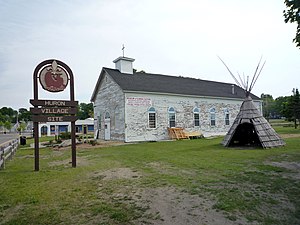Fort de Buade
| Fort de Buade | |
|---|---|
 | |
| Type | Fort |
| Built | 1683 |
| In use | 1683-1701 |
| Controlled by | New France |
| Battles/wars | Iroquois Wars - War with the English |
Fort de Buade was a French fort at the present site of St. Ignace in the U.S. state of Michigan. It was garrisoned between 1683 and 1701.
The mission
The French-Canadian settlement at St. Ignace began with the Mission of Saint Ignace, founded by Father Jacques Marquette, S.J. in 1671. By 1680 it had become a considerable community consisting of the mission, a French village of a dozen cabins, a walled Huron Indian town and an adjacent Ottawa town, also walled. In 1681, the assassination of the Seneca chief Annanhac by the Huron and Illiniwek at Saint Ignace warned the French that this community bore watching. Sharp practice by the fur traders also caused tensions. In 1683, Governor Antoine le Febvre de La Barre ordered Daniel Greysolon Du Luth and Olivier Morel de La Durantaye to establish a strategic presence on the north shore of the Straits of Mackinac, where Lake Michigan and Lake Huron come together. They fortified the Jesuit mission and La Durantaye settled in as overall commander of the French forts in the northwest: Fort Saint Louis des Illinois (Utica, Illinois), Fort Kaministigoya (Thunder bay, Ontario), and Fort la Tourette (Lake Nipigon, Ontario). He was also responsible for the region around Green Bay.
In the spring of 1684, La Durantaye led a relief expedition from Saint Ignace to Fort Saint Louis des Illinois which had been besieged by the Seneca. That summer and again in 1687, La Durantaye led coureurs de bois and Indians from the straits against the Seneca homeland in upper state New York. During these years, English traders from New York penetrated the Great Lakes and traded at Michilimackinac. This, and the outbreak of war between England and France in 1689 led to the construction of Fort de Buade in 1690 by the new commandant Louis de La Porte de Louvigny.
The forts
Fort de Buade at St. Ignace
During the 1690s, the fort became a staging area for French and Indian attacks against the Seneca, allied to the English. It remained an important fur trading center and a distribution point for arms and munitions for the war against the Iroquois. In 1694 Governor Frontenac sent an aggressive young protege, Antoine de la Mothe Cadillac, to run the post. Cadillac made a small fortune as the post commander, possibly by collecting bribes. In 1697, the Huron chief Kondiaronk from Michilimackinac led an attack on the Seneca on Lake Erie which resulted in a crushing victory and dashed the Iroquois' hopes for victory against the French. Four years later, Kondiaronk took a leading role in forging the Great Peace of Montreal which would conclude the war.
Relations between the fort and the adjacent Jesuit mission were not good during Cadillac's tenure. La Durantaye had ruled Michilimackinac with a firm hand. He controlled the trade in brandy, policed the fur trade, and kept the traders in line. An honest man, he would spend the last years of his life in relative poverty. Cadillac did not trouble himself with this sort of thing. In fact, much of the alcohol at the post was actually supplied by Cadillac himself. The missionaries, led by Etienne de Carheil, accused Cadillac of encouraging the sale and trading of brandy to the Native Americans. Cadillac may have seen this move as a necessary tactic to check the English traders. In any case, it was a necessary tactic in his own financial plans.
Despite Cadillac's liquor trade, Anglo-French commercial competition continued. Cadillac was replaced as commandant by Alphonse Tonti, brother of the explorer Henri Tonti. In 1701, Cadillac asked permission from Paris to found a new post on the Detroit River, to interdict the flow of British trade goods into the Lake Huron area. The Fort de Buade garrison helped give birth to the future city of Detroit.
The 1690-1701 Fort de Buade was probably a wooden stockade. It is believed to have been located on a site within the current municipality of St. Ignace, possibly on a hill above Moran Bay locally called "Fort Hill." The fort could also have been located on the bay's waterfront. As of August 2009 the fort's remains had not yet been identified.
The successor fort near Mackinaw City
Between 1701 and 1715 there was no official French-Canadian presence at the Straits of Mackinac, although unlicensed fur trading by coureurs des bois no doubt continued during this period. In 1715 a French detachment under Marchand de Lignery re-established a presence at the Straits of Mackinac in preparation for a war against the Fox nation in Wisconsin (Fox Wars). The new post, called Fort Michilimackinac, was raised on the south shore of the Straits near the present location of Mackinaw City, Michigan. Most of the Hurons had gone south to Detroit with Cadillac in 1701. The Ottawas moved from Moran Bay to the new fort and the Saint Ignace area was largely abandoned until the nineteenth century.
References
- Timothy J. Kent, Rendezvous at the Straits: Fur Trade and Military Activities at Fort de Buade and Fort Michilimackinac, 1669-1781
- Claiborne A. Skinner, The Upper Country: French Enterprise in the Colonial Great Lakes (Baltimore: The Johns Hopkins University Press, 2008)
- William J. Eccles, Frontenac: The Courtier Governor (Toronto: Mclelland & Stewart, 1957)
- Gilles Havard, The Great Peace of 1701 (Montreal: MacGill-Queen's University Press, 2001)
External links
Coordinates: 45°30′57″N 84°26′00″W / 45.51583°N 84.4333333°W
Retrieved from : http://en.wikipedia.org/wiki/Fort_de_Buade